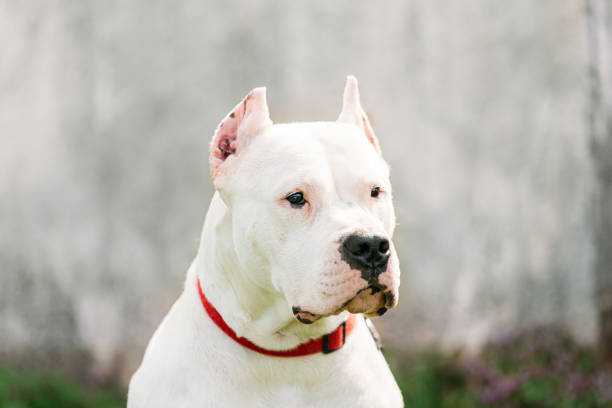The Dogo Argentino is a pack-hunting dog designed to go after a large game like wild boar and pumas. It has all the power, brains, and quick reflexes of a dedicated athlete. His short, smooth coat is white, although a small, dark patch that does not cover more than 10% of the head is allowed near the eye. A study in harmony, the Dogo Argentino is ideal. He’s big, strong, and athletic. His balanced frame is supported by straight, substantial forelegs and muscular, medium-angulated hindquarters. His powerful head is held up by a robust, yet graceful neck that joins to a balanced body. The Dogo appears to possess explosive force and vigor. Dogo must have a good nose, considerable lung capacity, and a powerful, yet agile, muscular frame in order to detect, pursue, and catch risky games. He has a sharp, intellectual, and noticeably hard expression. The Dogo is easily recognized by his short, all-white coat.
Dogo Argentino
Average sizes and life
expectancy of the breed.
Height
24-26.5 inches (male)
24-25.5 inches (female)
Weight
80-100 pounds
Life Expectancy
9-15 years
Breed Traits & Characteristics
About the Breed

Owning a dog is not just a privilege; it’s a responsibility. They depend on us for, at minimum, food and shelter, and deserve much more. When you take a dog into your life, you need to understand the commitment that dog ownership entails.
 Health
Health
 Grooming
Grooming
 Exercise
Exercise
 Training
Training
 Nutrition
Nutrition
History
This breed first appeared in the Republic of Argentina’s central (Mediterranean) province of Cordoba. It was developed by Dr. Antonio Nores Martinez, a famous physician, and descendant of an established family. He established the foundation and a standard for a new dog breed that he named Dogo Argentino in 1928 due to his passion for dogs, which may have come from family heritage. His research was focused on the careful mating of various purebred dogs with the powerful and ferocious old fighting dog from Cordoba. Dr. Nores Martinez achieved his goal of acquiring the first family after conducting a minute character research and selection process across several generations. It was initially thought of as a fighting breed. Still, Dr. Nores Martinez, who enjoyed hunting, took the dog on one of his regular hunting excursions where the new breed showed off its abilities and went on to play an important role in all of his outings. So, it swiftly developed into a great big-game hunting dog.
With time, this dog’s ability to adapt has made it very functionally adaptable; it has proven to be a noble friend as well as a devoted and impregnable protector of the people it loves. It is the best dog among those employed to hunt wild boars, peccaries, pumas, and other country predators that can be found in the wide and diverse sections of Argentinean land due to its strength, perseverance, keen sense of smell, and fearlessness. Its harmony, balance, and excellent athletic muscles make it the ideal creature for making long journeys in all weather, then engaging the chased prey in intense combat. Thanks to the dedication, hard work, and perseverance of Dr. Augustin Nores Martinez, the breed’s creator’s brother, and successor, the species was recognized by the FCI as the first and only Argentinean breed in 1973.




